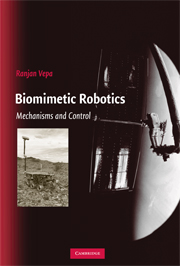Book contents
- Frontmatter
- Contents
- Preface
- Acronyms
- 1 The Robot
- 2 Biomimetic Mechanisms
- 3 Homogeneous Transformations and Screw Motions
- 4 Direct Kinematics of Serial Robot Manipulators
- 5 Manipulators with Multiple Postures and Compositions
- 6 Grasping: Mechanics and Constraints
- 7 Jacobians
- 8 Newtonian, Eulerian, and Lagrangian Dynamics
- 9 Path Planning, Obstacle Avoidance, and Navigation
- 10 Hamiltonian Systems and Feedback Linearization
- 11 Robot Control
- 12 Biomimetic Motive Propulsion
- Answers to Selected Exercises
- Appendix: Attitude and Quaternions
- Bibliography
- Index
11 - Robot Control
Published online by Cambridge University Press: 20 February 2010
- Frontmatter
- Contents
- Preface
- Acronyms
- 1 The Robot
- 2 Biomimetic Mechanisms
- 3 Homogeneous Transformations and Screw Motions
- 4 Direct Kinematics of Serial Robot Manipulators
- 5 Manipulators with Multiple Postures and Compositions
- 6 Grasping: Mechanics and Constraints
- 7 Jacobians
- 8 Newtonian, Eulerian, and Lagrangian Dynamics
- 9 Path Planning, Obstacle Avoidance, and Navigation
- 10 Hamiltonian Systems and Feedback Linearization
- 11 Robot Control
- 12 Biomimetic Motive Propulsion
- Answers to Selected Exercises
- Appendix: Attitude and Quaternions
- Bibliography
- Index
Summary
Introduction
Robot control is the engineering of how a controller is synthesized based on a representative model and implemeted, and how the robot is controlled while in operation. The robot-control problem is patently different from other applications of control engineering, in that no attempts are made to linearize the governing dynamical equations by the application of the small-perturbation method. Rather, the inherent nonlinear nature of robot dynamics is accepted as a fait accompli and dealt with quite directly. There is also the issue of how the robot-control software is written and its architecture, but this is not considered here as it has to do with computer software. A broad understanding of the robot-control problem is essential as it has an impact on the kinematic design of the mechanism used in the robot for the purpose of motion transmission.
A simplistic model of a robot is to look at it as a collection of links connected by joints. As the joints rotate or move and the links contract, expand, and reorient themselves, the tip of the robot's end-effector or tool center point (TCP) will change its position. To design a practical manipulator, it is not only of great importance to know the position of the TCP in world coordinates but it is also vital that it be predictable and controllable. Thus the actuators in the joints of the robot have to be controlled in a complex and deterministic manner to follow a prescribed sequence of set points or control commands.
Considering the classical nonlinear joint control problems associated with a robot, we observe that these are essentially adaptive because the robot link parameters are almost always not known accurately.
- Type
- Chapter
- Information
- Biomimetic RoboticsMechanisms and Control, pp. 242 - 271Publisher: Cambridge University PressPrint publication year: 2009

